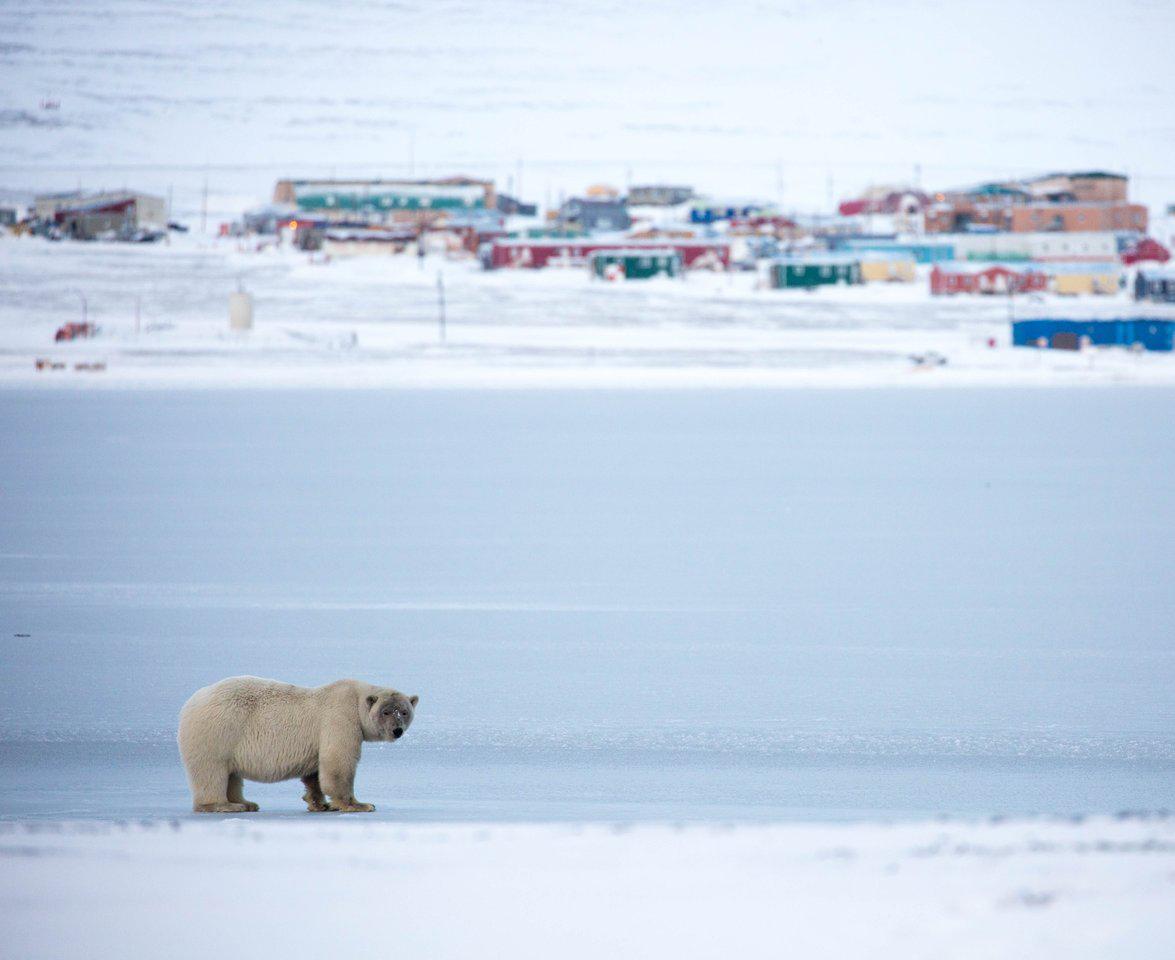It is located right on the Arctic Circle, at the north end of Repulse Bay on the southern shores of Rae Isthmus. The Inuktitut name of this community is ‘Naujaat’ (‘seagull nesting place’) for a cliff area nearby where fledgling seagulls are born each June. Its people are the Aivilingmiut (‘people of the walrus place’), direct descendants of the ancient Thule people, known for their excellent dog teams and walrus hunting skills.
It’s a great place for viewing polar bears and for whale watching excursions, plus it is located close to beautiful Ukkusiksalik National Park, which is a 15-minute plane ride away.
1,050
95% Inuit
Inuktitut, English
Longitude 86° 13’ W
Latitude 66° 31’ N
Elevation 24m
The local landscape has many scenic inlets with rolling hills, bird cliffs, tundra flats and numerous small lakes.
Weather & Climate
Summer temperatures range from 10°C to 25°C. The prevailing wind direction is from the northwest, averaging 17 kph (11 mph) yet sometimes gusting to 100 kph (62 mph). The winter temperature drops to -45°C. Snowfalls can happen at any time in the spring, fall and winter months.
| Average Temperature in Naujaat | |||
|---|---|---|---|
| January | -31oC | February | -31oC |
| March | -26oC | April | -17oC |
| May | -7oC | June | 3oC |
| July | 8oC | August | 6oC |
| September | 0oC | October | -8oC |
| November | -19oC | December | -26oC |
HISTORY
The local Inuit people are Aivilingmiut descendants of the ancient Thule people who lived here from 1000 AD to 1600 AD. This unique group of Inuit moved south into Naujaat from the region near present-day Igloolik and Hall Beach. The Melville Peninsula area of Nunavut has been home to indigenous peoples since 2500 BC.
- Pre-Dorset Culture (‘Saqqaq’): 2500 BC to 500 BC
- Dorset Culture (‘Tuniit’ or ‘Sivullirmiut’): 500 BC to 1500 AD
- Thule Culture (Proto-Inuit): 1000 AD to 1600 AD
- Inuit Culture (Eskimo): 1600 AD to present-day
Europeans visited this bay in 1742 when the British explorer Christopher Middleton was searching for the Northwest Passage. The English name ‘Repulse Bay’ is usually attributed to him. When he discovered that the bay was not a viable route to the East Indies, but rather a cul-de-sac, he is claimed to have called it the ‘Bay of Repulse, the bay where I was pushed away.’
Some people speculate that the English name for this place may instead come from an 18th century British ship called the ‘Repulse’ that supposedly also visited this area, but there have been twelve ships in the British Royal Navy called ‘HMS Repulse’ and the 18th century one sank in a hurricane near Bermuda in 1776. Repulse Bay in Hong Kong has the exact same problem with its English name too! To resolve this ongoing friendly dispute here, most locals just chuckle and call the place ‘Naujaat’ instead. Throughout the 1800s it was a popular destination for American and Scottish whalers, employing many local Inuit hunters who worked aboard the whaling vessels and were expert trackers of the bowhead whale migrations.
The Hudson Bay Company opened a fur trading post in Repulse Bay in 1916. A rival fur trading company called Révillon Frères opened another post here in 1923. The Catholic mission was built in 1932. In 1968 the Government of Canada began a major infrastructure program in Repulse Bay that included construction of the Tusarvik School, plus 20 three-bedroom homes for local Inuit people, three staff houses for government employees, a power plant, a warehouse and two enormous fuel storage tanks.
The first permanent station of Royal Canadian Mounted Police was established in 2002. Most residents continue to rely on traditional seal and caribou hunting, fishing, trapping and carving for their livelihood. Tourism is increasingly popular here and mining exploration is also taking place nowadays.
ACTIVITIES AND WILDLIFE
There are many species of birds, including snow buntings, loons, eider ducks, jaegers, snowy owls, terns, ravens, ptarmigans, tundra swans, peregrine falcons, gyrfalcons, rough-legged hawks, snow geese and sandhill cranes. Just north of the community is the cliff area where ‘naujaat’ (fledgling baby seagulls) are born in the early summertime.
ARTS AND CULTURE
Repulse Bay artists create many fine works of jewellery and its carvers are famous for their realistic animal sculptures made of ivory, bone, soapstone, marble and antler. Inuit artwork can often be purchased directly from the artists when you are visiting here.
Parks
Ukkusiksalik National Park of Canada
This beautiful historic national park is located close to Repulse Bay, a 15-minute plane ride away. The 145 kilometre (90 mile) journey can also be done by boat, snowmobile or dog sled, depending on the season.
Named after the soapstone (steatite) that is found here, the word ‘ukkusiksalik’ means ‘where there is material for the stone pot’ in Inuktitut. The park surrounds a 100 kilometre (62 mile) long inlet called Wager Bay. In addition to a reversing waterfall to visit and hundreds of archaeological sites dating back to 1000 AD, the park protects important habitat for arctic hares, arctic foxes, arctic wolves, muskoxen, caribou, barren land grizzly and polar bears, plus beluga and bowhead whales, gyrfalcons, peregrine falcons and golden eagles.
The landscape features eskers, cliffs, mudflats and rolling tundra. The camping, hiking and wildlife viewing experience here is fantastic. It is recommended that visitors hire an expert local outfitter from Repulse Bay to safely guide them into and out of this park due to the large polar bear population.

